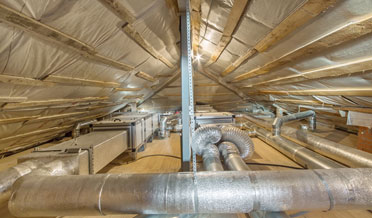Ductwork Cleaning: How to Keep Allergens at Bay
Ductwork Cleaning and Its Effect on Allergens
We are surrounded by airborne particles that are too small to see. Many of these small particles irritate the respiratory system, from nose to lungs, causing itchy eyes, runny nose, sneezing, and coughing. How serious is this problem? Fifty million Americans suffer from allergies1 and twenty-five million Americans suffer from asthma2. Most of these particles originate outdoors but find a way into our homes. Once inside, they accumulate to produce poor indoor air quality, since we close windows and doors to keep extreme temperatures outside. Reduced ventilation produces air 2 to 5 more polluted than outdoor air.
Most Common Allergens
- House dust. While dust may seem innocent enough, there is more to dust than meets the eye. A large percentage of dust was once skin cells in our own bodies. However, these cells pick up tiny travelers that make dust a problem. Microscopic arachnids called dust mites feast on the cells and there is no way to keep them from migrating into our homes. Dust mites do not bite, sting, or burrow; however, their feces and urine produce proteins that are irritants to mucus membranes.
- Pet hair and dander. If we bring animals into our homes as pets, they contribute to the dust and mite problem, but the proteins within the animal dander add to the types of irritants. Some people unaffected by human cell proteins are very allergic to animal proteins.
- Trees and grasses reproduce by releasing pollen into the air to fertilize flowers of the same kind. As you can imagine, people who are not irritated by animal proteins are highly allergic to plant proteins. Pollen is released in great quantities during the species flowering season. (Ragweed is the worst for me).
- Mold and mildew spores. Mold and mildew are fungi. They do not reproduce via pollen, but with a seed-like spore that moves freely in the air. Yes, still another form of protein, neither animal nor plant, affects a new set of sinuses with allergies.
These common allergens come into our homes every time a window or door opens. They rest on our skin, our clothes, and our shoes. Once inside, the heating/cooling cycles of the HVAC system distribute them to every space, and they fall onto every surface. There really is no way to keep them outside.
Ductwork Cleaning Reduces and Removes Allergens
If being outdoors caused allergic reactions, being indoors is potentially worse. Here are some common ways that we clean up our indoor air.
- HVAC air filters. Your HVAC system has an air filter, a first line of defense against allergens. Here are some relevant facts about choosing an effective filter. MERV rating for air filters measures the percentage of airborne particles they collect, based on the size of the particle. The higher the MERV number, the better the results; seek MERV 8 to 11 for good results. (Higher-rated filters may restrict sufficient airflow to hamper normal functions.) Make sure to keep the filter changed regularly, at least every three months. A clogged filter loses effectiveness and restricts airflow.
- Regular cleaning. If someone in your family is particularly vulnerable to allergens, careful cleaning is extremely important. Dusting, vacuuming and mopping permanently remove allergens from surfaces around the house. Be sure to change/clean bedding frequently. Any items associated with pets should be handled carefully to minimize the amount of dander released into the air.
- Clean ductwork. Airborne particles that successfully bypass the air filter are pushed into the network of ducts spread around the house. When the cycle stops, the particles drop to the duct surface. Cleaning the ducts removes the accumulation of dust in hard-to-reach spaces. Ducts should be cleaned every three to five years for best results.
- Install UV lights. The airborne particles that cause allergies have one thing in common: they are organic in makeup. Ultraviolet light offers a solution. UV light disrupts the cell walls of animal, plant, and fungi varieties. When installed inside HVAC ductwork, the light neutralizes organic material, rendering them inert material to be collected by the air filter.
- Use the air conditioner. Mold and mildew require dark, moist areas with plenty of organic material to eat. The air conditioner removes humidity from the air, depriving spores of a needed element.
Need assistance with your Ductwork Cleaning?
With our four decades of experience as an AC Repair and Ductwork Cleaning contractor, AirPro Houston provides you with the skill and expertise to assist with the steps to answer questions about Ductwork Cleaning.
We have several financing options available with great options with up to 72-month terms with approved credit. Call us today at 281-880-8805 and let us partner with you for all of your Furnace Repair, Tune Up maintenance, and AC Replacement needs.

1 https://aafa.org/allergies/allergy-facts/#:~:text=More%20than%2050%20million%20people,types%20of%20allergies%20each%20year.&text=Allergies%20are%20the%20sixth%20leading%20cause%20of%20chronic%20illness%20in%20the%20U.S
2 https://aafa.org/asthma/asthma-facts/#:~:text=How%20Common%20Is%20Asthma%3F,about%201%20in%2013%20people.&text=About%2020%20million%20U.S.%20adults%20age%2018%20and%20older%20have%20asthma
